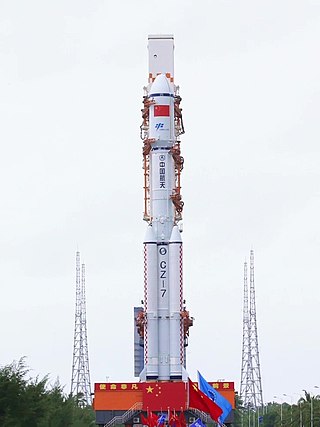Related Research Articles

The Chengdu Metro is the rapid transit system of Chengdu, the capital of Sichuan, China. With the opening of Line 1 on 27 September 2010, the system consists of 12 subway lines and 1 light rail line. It has subsequently undergone rapid expansion. Since the opening of Lines 6, 8, 9, and 17 on 18 December 2020, the Chengdu Metro is the 4th longest metro system in the world.

The YF-100 is a Chinese liquid rocket engine burning LOX and kerosene in an oxidizer-rich staged combustion cycle.

The Long March 7, or Chang Zheng 7 in pinyin, abbreviated LM-7 for export or CZ-7 within China, originally Long March 2F/H or Chang Zheng 2F/H, nicknamed Bingjian, is a Chinese liquid-fuelled launch vehicle of the Long March family, developed by the China Aerospace Science and Technology Corporation (CAST). It made its inaugural flight on 25 June 2016.
The YF-115 is a Chinese liquid rocket engine burning LOX and kerosene in an oxidizer-rich staged combustion cycle. A high efficiency/high thrust environmental-friendly rocket engine was always an objective within Programme 863. Development began in the 2000s, along with its sibling, the bigger YF-100, which would power the LM-5, LM-6 and LM-7 boosters and first stages. Testing was directed by the China National Space Administration (CNSA) commencing in 2005. Development works are mainly carried out by the Xi'an Aerospace Propulsion Institute. It will be used as upper stage engine for China's next generation of medium and light environmental-friendly launch vehicles, namely the Long March 6 and the Long March 7. During early 2012, the engine system successfully passed vacuum testing. It is China's first upper stage rocket engine to adopt the staged-combustion cycle.

The TQ-12 is a gas-generator cycle rocket engine burning liquid methane and liquid oxygen under development by Landspace. TQ-12 is the first Chinese liquid rocket engine developed with private funding. The engine has been designed to produce 670 kilonewtons (150,000 lbf) of thrust at sea level.
Tiantong is China's first mobile communications satellite system. The first satellite Tiantong-1-01 was launched on August 6, 2016 (UTC+8).
The YF-130 is a Chinese rocket engine fueled by LOX and kerosene in an oxidizer-rich staged combustion cycle currently in development. It has been designed to reach around 500 tonnes of thrust and it will power the super heavy Long March 9 rocket.

Tianzhou 4 was the fourth mission of the Tianzhou-class unmanned cargo spacecraft, and the third resupply mission to Tiangong Space Station carrying 5 tons of cargos and 1 ton of propellant. It is the largest load capacity cargo spacecraft that is on active duty. It launched on 9 May 2022, docking successfully with the Tiangong space station at the aft port 6 hours after launch. Like previous Tianzhou missions, the spacecraft launched from the Wenchang Satellite Launch Center in Hainan, China on a Long March 7 rocket.

The DJF2"Xianfeng" electric multiple unit is a model operated formerly by China Railway with traction motors distributed throughout the unit. It was developed in 2001 as a key task of the science and technology targets of the Ninth Five-Year Plan. It was an innovative and advanced design being the first Chinese multiple unit train to achieve 200 km/h (124 mph) and achieving a top test speed of 292.8 km/h (181.9 mph) in tests, but had numerous flaws in the design that complicated operations.
The YF-79 is a liquid cryogenic rocket engine burning liquid hydrogen and liquid oxygen in a closed expander cycle. It is China's fourth generation of upper stage cryogenic propellant engine, after the YF-73, YF-75 and the YF-75D. It can do multiple restarts thanks to an electric spark igniter and a prototype was tested at 60% and 100% thrust levels in December 2021.
The YF-90 is a liquid cryogenic rocket engine burning liquid hydrogen and liquid oxygen in a staged combustion cycle. It is China's first hydrogen-oxygen engine to use the staged combustion cycle and is expected to be used for the second stage of the Long March 9, which is a three-stage rocket with boosters. The engine has advanced features such as variable thrust, multiple ignitions, and automatic fault diagnosis.
The TH-11 is an oxidizer-rich staged combustion cycle rocket engine burning LOX and kerosene developed by Space Pioneer. The TH-11 engine features a reusable design, staged combustion cycle, wide usage of 3D printed components (>80%), and short development time, making it a notable achievement within the Chinese commercial space industry.
References
- ↑ "天火-12 - 天火系列发动机 - 天兵科技". www.spacepioneer.cc. Space Pioneer. Retrieved 25 November 2022.
- ↑ "天兵科技百吨级液体火箭发动机半系统热试车圆满成功". www.jiuyoucapital.com.cn. Retrieved 25 November 2022.
- ↑ Brügge, Norbert. "SpacePioneer". www.b14643.de. Retrieved 25 November 2022.
- ↑ Chang, He. "天兵科技 110 吨液体火箭发动机全系统热试车成功". ithome. Retrieved 25 November 2022.
